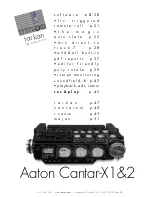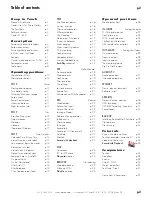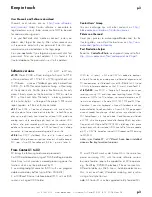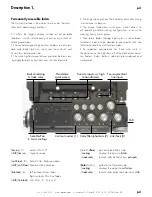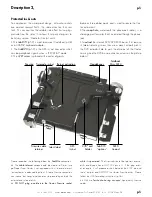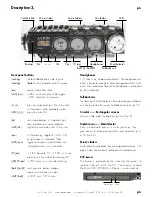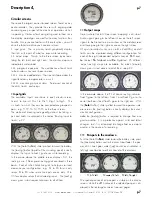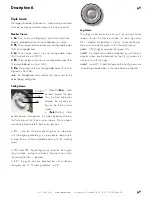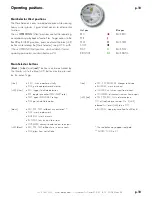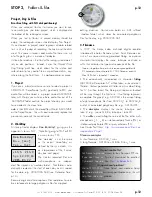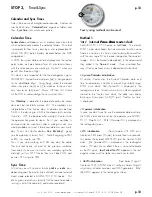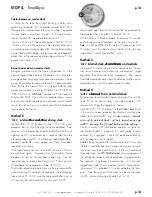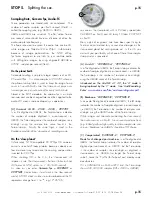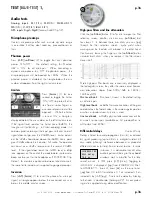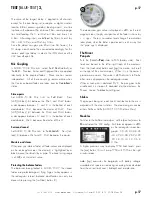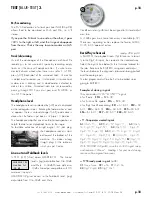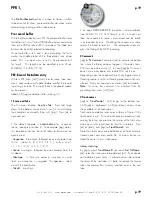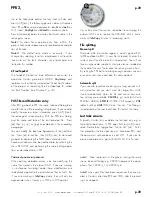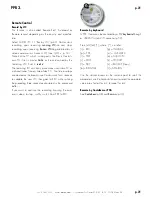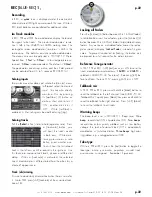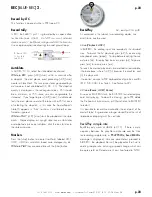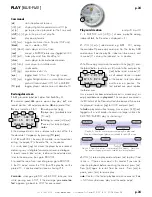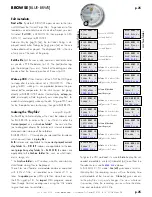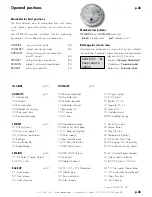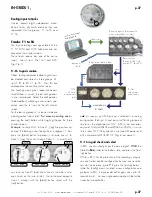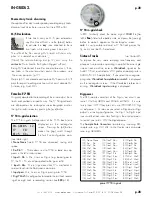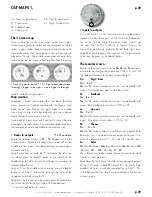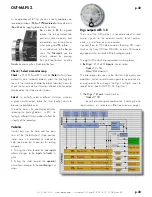
+33 4 7642 9550
www.aaton.com
User manual for Cantar-X1 & X2 v2.15 2008 March 28
p.15
p.15
Sampling Rate, Camera fps, Audio-TC
These parameters are theoretically not correlated. The
number of audio samples per Earth second (Hertz), is
called the sampling rate, e.g. 48000 is 48kHz.
48kHz and 96kHz are universal, The film/video ‘frames
per second’ value should have no influence at all on the
audio sample rate frequency.
The frame-rate used to express the audio time can be 30,
while images are filmed at 24 or 25fps! Unfortunately,
because of vintage post-machines, the NTSC drifting
fps forces engineers to use tricks to sync real-time audio
with drifting-time images, by using disgraceful 48048 or
47952 samples per second (Hertz).
On the planet Earth
Timecode handling is simple at integer speeds such as 24,
25 and 30fps.
It is more complex at 29.97DF where a
drop-frame lookup table is used to keep the image frame
count in line with Earth’s time: the frame count jumps over
two images every minute except for every tenth minute.
Stored in the BWF metadata, the camera fps is a simple
reminder and can be changed later and then applied to the
audio LTC used in some audio-post sync operations.
[U] Universal : 24.00 ... 25.00 ... 30.00 ... 29.97DF
In a file digitized at 48kHz, the Format stamp indicates
the number of samples digitized in a real-second, i.e.
48000; the Time-stamp carries the number of samples since
midnight using the sample rate value found in the
Format stamp.
Exactly the same logic is used in the
Barebone mode-B of the ‘slow-planet’ recording mode.
On the ‘slow-planet’
Unfortunately, NTSC-compatible 23.976fps HD cameras
cannot use anti-drift lookup tables because nobody ever
found a clever way to emulate the counting compensation
invented for 29.97fps.
When shooting HD in the U.S., the ‘slow-second’ still
imposes its rule.
The slow-second is the time it takes to shoot
30 frames of NTSC video, i.e. 1.001 Earth second).
As soon as you enter
Camera fps = 23.98NDF
or
29.97NDF
, Cantar knows it must work in the ‘slow-second’
world, its TCXO clock switches to a slower beat and the TC
separators change from ‘
:
’ to ‘
*
’, e.g.12*45*36;
you are on the slow-planet with its 24 lazzy speed (aka
23.98NDF on Earth) and 30 lazzy TC (aka 29.97NDF
on Earth).
Many nights of engineers’ time have been spent trying to
find a universal method to sync sound and images on the
slow-second planet but nothing came out. In the U.S. you
must ask your post-facility which one of these
three sample-
stamp modes
is requested:
(A)
Avid v11: '23.98NDF–A', '29.97NDF–A'
In a file digitized at 48kHz, the Format stamp indicates the
number of samples digitized in a slow-second, i.e. 48048;
the Time-stamp is the number of samples since midnight,
using the 48048 value of the Format stamp.
Introduced on the AvidMC v11.3.2, the ‘A’ mode is
being replaced by the ‘C’ mode. See ‘Avid-Recording-
Rates’
www.aaton.com/files/avid-recording-rates.pdf.
(B)
Barebone: '23.98NDF–B', '29.97NDF–B'
In an audio file digitized/recorded at 48kHz, the '
B
' stamp
indicates the number of samples digitized in a real-second,
i.e. 48000; the Time-stamp is the number of samples since
midnight using the 48000 value of the Format stamp.
While images and timecode are beating the slow-second,
the audio remains on Earth! Since recent post-machines
(e.g. Indaw) perform high quality real-time sample rate con-
version, ‘Barebone’ and 48kHz should be THE choice.
(C)
Compensated: '23.98NDF–C', '29.97NDF–C'
Mode for challenged post-machines:
in a file digitized at
48kHz, the Format stamp indicates the number of samples
digitized per real-second, i.e. 48000, but the Time-stamp
is the number of samples since midnight as digitized in
slow-seconds, i.e. 48048 (no longer the Format stamp
value!), hence the ‘F’ suffix (for Fake or Faux) used by some
manufacturers.
If it is 02h00m00s on Earth at REC start, the Time-stamp
shows 345,945,600 samples (02h x 3600s x 48048).
STOP 5.
Splitting the sec.

